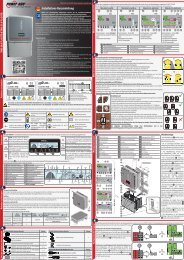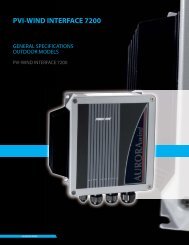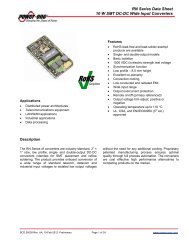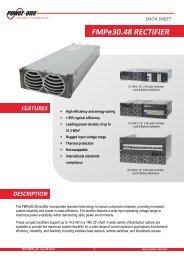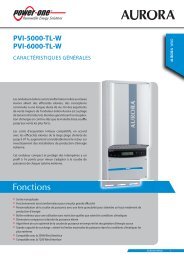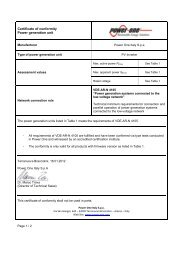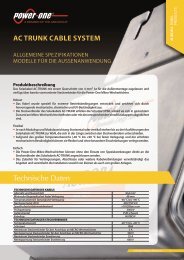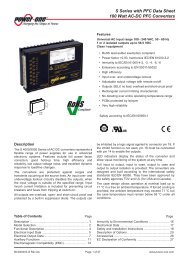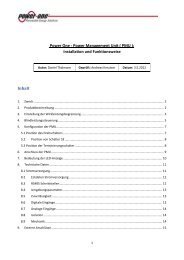YS05S16 DC-DC Converter Data Sheet - Power-One
YS05S16 DC-DC Converter Data Sheet - Power-One
YS05S16 DC-DC Converter Data Sheet - Power-One
You also want an ePaper? Increase the reach of your titles
YUMPU automatically turns print PDFs into web optimized ePapers that Google loves.
<strong>YS05S16</strong> <strong>DC</strong>-<strong>DC</strong> <strong>Converter</strong> <strong>Data</strong> <strong>Sheet</strong>3.0-5.5 V<strong>DC</strong> Input; 0.7525-3.63 V<strong>DC</strong> Programmable @ 16 AOperationsInput and Output ImpedanceThe <strong>YS05S16</strong> converter should be connected via alow impedance to the <strong>DC</strong> power source. In manyapplications, the inductance associated with thedistribution from the power source to the input of theconverter can affect the stability of the converter.The use of decoupling capacitors is recommended inorder to ensure stability of the converter and reduceinput ripple voltage. Internally, the converter has44 μF (low ESR ceramics) of input capacitance.In a typical application, low - ESR tantalum or POScapacitors will be sufficient to provide adequateripple voltage filtering at the input of the converter.However, very low ESR ceramic capacitors100 - 200 μF are recommended at the input of theconverter in order to minimize the input ripplevoltage. They should be placed as close as possibleto the input pins of the converter.The <strong>YS05S16</strong> has been designed for stableoperation with or without external capacitance. LowESR ceramic capacitors placed as close as possibleto the load (minimum 100 μF) are recommended forimproved transient performance and lower outputvoltage ripple.It is important to keep low resistance and lowinductance PCB traces for connecting load to theoutput pins of the converter in order to maintain goodload regulation.Fig. A shows input voltage ripple for various outputvoltages using four 47 μF input ceramic capacitors.The same plot is shown in Fig. B with one 470 μFpolymer capacitor (6TPB470M from Sanyo) inparallel with two 47 μF ceramic capacitors at fullload.Input Voltage Ripple [mVp-p]32282420161284Vin = 3.3VVin = 5.0V00 1 2 3 4Vout [V]Fig. B: Input Voltage Ripple, C IN = 470 μF polymer + 2 x 47 μFceramic.ON/OFF (Pin 1)The ON/OFF pin is used to turn the power converteron or off remotely via a system signal. There are tworemote control options available, positive logic(standard option) and negative logic, with bothreferenced to GND. The typical connections areshown in Fig. C.To turn the converter on the ON/OFF pin should beat a logic low or left open, and to turn the converteroff the ON/OFF pin should be at a logic high orconnected to Vin. See the Electrical Specificationsfor logic high/low definitions.VinR*VinON/OFFY-Series<strong>Converter</strong>(Top View)SENSEVout24GNDTRIMRloadInput Voltage Ripple [mVp-p]20161284Vin = 3.3VVin = 5.0V00 1 2 3 4Vout [V]Fig. A: Input Voltage Ripple, CIN = 4 x 47 μF ceramic, full load.CONTROLINPUTR* is for negative logic option onlyFig. C: Circuit configuration for ON/OFF function.The positive logic version turns the converter onwhen the ON/OFF pin is at a logic high or left open,and turns the converter off when at a logic low orshorted to GND.The negative logic version turns the converter onwhen the ON/OFF pin is at logic low or left open, andturns the converter off when the ON/OFF pin is at alogic high or connected to Vin.MCD10205 Rev. 1.0, 24-Jun-10 Page 5 of 25 www.power-one.com



